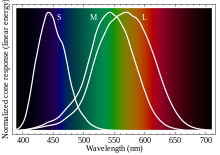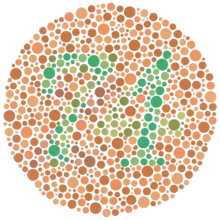Color blindness

People with color blindness[1] cannot tell the difference between certain colors. They may not see colors at all.
Most color blindness is inherited, usually as simple Mendelian inheritance. Sometimes, it is the result of damage to the eyes, nerves, or the brain. It can be caused by coming into contact with certain chemicals.
Most color blindness is permanent. Some conditions can lead to temporary color blindness. During certain kinds of migraine, some people are unable to tell the difference between certain colors. There is no treatment cure for permanent color blindness.
Many more males are color blind than females. Between five and eight percent of males, but less than one percent of females, are color blind.[2]
People usually think of color blindness as a disability. However, people who are color blind have one advantage: they are sometimes better at seeing through some types of camouflage.[3]
History
[change | change source]In 1798, English chemist John Dalton published the first scientific article about color blindness. That was after he found out that he was color blind.[4] Because of this, the condition is sometimes called daltonism. As of 2009, the word daltonism is used only for the type of color blindness called deuteranopia.
Seeing color
[change | change source]There are three steps in the process of telling the difference between colors:
- Light hits specialized nerve cells in the eye. Those cells are called receptors. Some of them are stimulated and create an electrical signal.
- The signals move along nerves to special parts of the brain.
- Those parts of the brain interpret the signals. The signals are changed into an image. This image is then carefully looked at to separate different objects, to see shapes and sometimes colors, and to link these to other kinds of information.
How the human eye sees colors
[change | change source]
Inside the human eye is a part called the retina. The retina receives the images that the eye sees. It sends the images to the brain. The retina has two types of cells: rod cells and cone cells. They work in different types of light.
- Rod cells receive the images that the eye sees when the light is dim, at night, or in a dark room.
- Cone cells receive the images that the eye sees in normal daylight or in bright light. There are three types of cone cells. Each type has a different chemical photopsin and reacts to a different spectrum of light. One is specially sensitive to short wavelengths. Another is sensitive to medium wavelengths. The third is sensitive to long wavelengths. These wavelengths cover much of the visible light. Each color is "seen" as a result of how much each of the receptors is stimulated.
How the brain works out the colors
[change | change source]Parts of the thalamus and the visual cortex in the brain are involved in seeing, also seeing colors. Color blindness can therefore also result if these areas of the brain, the optic nerve or the retina have been damaged. These types of color blindness happen because of an accident. They are not inherited. Inherited forms of color blindness affect the retina only.[5]
That way it is possible that only a part of the visual field is affected by color blindness, but in the rest, there is no color blindness.
Some types of color blindness, but not inherited color blindness, can be cured.
Causes of color blindness
[change | change source]There are several different problems that can cause color blindness.
- If a person's eye has no cone cells, then they cannot see any color at all. They can only see shades of dark and light.
- There are three types of cone cells in the human eye. If there are two types, a person will have a hard time to tell certain colors apart. If there is only one type, a person will not see color at all.
- Sometimes cone cells change. This means that they no longer react to those wavelengths they should. A person will need more of a certain color to see this color. They see colors differently, and may not be able to tell certain colors apart. Most of these people do not know they are color blind, as they have little difficulty telling colors apart in most cases.
- There may be nothing wrong with the eye, but the nerves that transport the information or the area in the brain that interprets it may be damaged. This means that the signal is interpreted the wrong way. The damage may be permanent, or it may be temporary. Certain conditions of the brain, like a migraine can change the way people see colors.
Different types of color blindness
[change | change source]Total color blindness
[change | change source]Total color blindness is very rare. People who suffer from it can only see in black, gray and white. They can perceive only differences in brightness and do not see color.[6] This is called monochromacy.[6]
There are two main types of total color blindness:
- Rod monochromacy (achromatopsia): The retina has no cone cells. This makes it difficult to see even lights of a normal level; this means that people who suffer from it are almost blind. It occurs almost only on the island of Pingelap, a part of the Pohnpei state in the Federated States of Micronesia. There it is called maskun: about one person in 12 of the population has it. The island was hit by a storm in the 18th century. Very few men survived the storm. One of them carried a gene for rod monochromacy. Today, several hundred people live on the island, about 30% have this gene.
- Cone monochromacy: The retina has both rods and cones, but only one type kind of cone. People who suffer from this will be able to see patterns well, in normal daylight, but they will not see hues.
Red/green color blindness
[change | change source]There are two kinds of red-green color blindness: protanopia or deuteranopia. Deuteranopia is the most common form of color blindness; between five and ten percent of males suffer from it. It is called Daltonism because John Dalton discovered it. Those affected have trouble telling the difference between red and green. As seen by protanopes (people suffering from protanopia), red is darkened. Most often, this is because they lack the receptors for long (protanopia) or medium (deuteranopia)-length light waves or because these receptors have changed their sensitivity.
Blue/yellow color blindness
[change | change source]Although the name is blue-yellow color blindness (tritanopia), people affected by this type of color blindness can usually tell the difference between blue and yellow. Instead they cannot tell the difference between blue and green, and also yellow and violet.[7] It is different from the other types of color blindness because it is not linked to sex. It is equally possible for males or females to develop blue-yellow color blindness. It is caused by having few or no cones in the retina which can sense short wavelength light.
Other causes of color blindness
[change | change source]Sometimes, people do not have problems seeing color, but their brain has trouble "telling" the color, and interprets it wrongly. It is also possible that only certain parts of the eye have color blindness; people may become color blind because of other diseases, but after the disease goes away, see normally again. This seems to be the case with certain forms of migraine.
How color blindness is inherited
[change | change source]Males have one X and one Y chromosome; females have two X chromosomes. Many of the genes involved in making color vision work are on the X chromosome: they are sex linked. For this reason, men are more often affected by color blindness than women.
The "color blind" gene allows non-color blind people to see the difference between red and green. The gene is located on the X chromosome. This means that a male will be color blind if the single X he inherits from his mother contains the color blind version of the "color blind" gene. A female will inherit color blindness only if she inherits two X chromosomes containing defective (mutant) color gene alleles. In other words, a female needs to inherit "color blind" genes from both parents in order to be color blind.
Testing someone for color blindness
[change | change source]
The Ishihara plate test has been in use since 1917. Each plate has an image with dots of different size and color. People will then see different images (most often numbers). Those with certain types of color blindness will see different numbers from those not affected by color blindness.
Because many young children have not learned numbers yet, other tests have been developed. They use symbols, like a square, a circle or a car instead of numbers.
Design changes
[change | change source]A color code is when there is much information in the color of certain item. Such codes cannot be understood easily by those who are color blind. For this reason, color should not be used alone to give information. Good graphic design avoids using color coding or color differences alone to give information. This does not only help color blind people, but also normally sighted people.
Cascading Style Sheets can be used on web pages. They allow to give a different color scheme for color blind people. Certain color scheme generators help graphic designers see color schemes as eight types of color blind people see them.[8]
Color blindness is very sensitive to changes in material. A red-green color blind person may be unable to see the difference between colors on a map printed on paper. The same map on a computer screen or television may appear normally. In addition, some color blind people find it easier to tell the difference between colors on artificial materials, such as plastic or in acrylic paints, than on natural materials, such as paper or wood. Thirdly, for some color blind people, color can only be distinguished if there is enough color: thin lines might appear black, but a thicker line of the same color can be seen in the correct color.

In certain cases when it is important to understand information very quickly, the visual system may drop the colors, and only work in shades of gray. This is important to know when designing the interfaces for objects that need to be used in an emergency situation, like emergency brakes, or emergency telephones.
Because color blind people may not see the difference between colors such as red and green, some countries, such as Romania have refused to give them driving licenses. In Romania, people have started to change the laws so that color blind people will also be able to drive legally.[9]
In the United Kingdom, electricity wires in houses used to be red, black and green. They were changed to brown, blue and green/yellow to help color blind people see the difference between the "live" and "earth" wires.[10]
What color blindness is not
[change | change source]Many people do not understand color blindness. People who are color blind never swap the colors they are blind to. They may have trouble telling two colors from one another. That way they may have a problem finding the right kind of apple in the supermarket. The image below first shows the way that two apples look to a person with normal vision, and then the way it looks to a person with red-green color blindness. The left apple is a Braeburn; it is red in color. The apple on the right is a Granny Smith; it is green. To someone with red-green blindness, the apples look like they are almost the same color.
References
[change | change source]- ↑ another term is color vision deficiency.
- ↑ Gegenfurtner, K.R.; Sharpe, L.T.; Boycott, B.B. (2001). Color Vision: from genes to perception. Cambridge University Press. ISBN 978-0-521-00439-8. Retrieved 2020-01-07.
- ↑ Morgan, MJ; Adam, A; Mollon, JD (1992-06-22). "Dichromats detect colour-camouflaged [sic] objects that are not detected by trichromats". Proceedings. Biological Sciences. 248 (1323). The Royal Society: 291–295. Bibcode:1992RSPSB.248..291M. doi:10.1098/rspb.1992.0074. ISSN 0962-8452. PMID 1354367. S2CID 35694740.
- ↑ Dalton J, 1798. "Extraordinary facts relating to the vision of colours: with observations" in Memoirs of the Literary and Philosophical Society of Manchester 5 28-45
- ↑ In cerebral achromatopsia, a person cannot perceive colors even though the eyes are capable of distinguishing them. This is usually not considered as true color blindness.
- ↑ 6.0 6.1 Byrne A, Hilbert D. "A Glossary of Color Science." Archived 2015-10-04 at the Wayback Machine Originally published in Readings on Color, Volume 2: The Science of Color. (MIT Press, 1997). Accessed November 7, 2006.
- ↑ "Tritanopia – Blue-Yellow Color Blindness". Retrieved 30 May 2012.
- ↑ Color Scheme Designer. For an example of a map that could present a significant problem to a color blind reader, see this graphic from a New York Times article. The typical red-green color blind reader will have a lot of difficulty telling the green sections from the orange ones. This makes the graphic unreadable.
- ↑ "Petition to European Union on Colorblind's condition in Romania". 15 August 2007. Retrieved 2007-08-21.
- ↑ "BBC h2g2 - Colour [sic] Blindness". Retrieved 2009-04-17.

